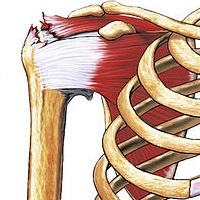
Photo from wikipedia
Massive rotator cuff tears (MRCTs) present a particular challenge due to high rates of retear that can range from 18 to 94%, failure of healing after repair, and potential for… Click to show full abstract
Massive rotator cuff tears (MRCTs) present a particular challenge due to high rates of retear that can range from 18 to 94%, failure of healing after repair, and potential for irreparability. Management of MRCTs must take into consideration the patient's characteristics, clinical examamination and expectation, number and quality of muscle tendons units involved. Conservative treatment, arthroscopic long head of the biceps tenotomy, cuff debridement, partial repair, and superior capsule reconstruction are viable solutions to treat selected patients. The goal of tendon transfers is to achieve stable kinematic by restoring rotational strength and force coupling of the shoulder joint. The ideal candidate is a young, motivated patient with small degenerative changes of the glenohumeral joint, a massive irreparable cuff tear, significant atrophy, fatty infiltration, and functional deficit. Patients with posterosuperior massive tears have impaired shoulder function with external rotation weakness and eventually lag sign If the teres minor is affected. Latissimus dorsi transfer is the most used with results lasting for long follow-up and lower Trapezius transfer is becoming a surgical option. For anterosuperior tears, there is still controversial if pectoralis major is the best option when compared to latissimus dorsi although this last has a similar vector force with the supraspinatus tendon. Complications associated with tendon transfers include neurovascular injury, infection, and rupture of the transferred tendon.
Journal Title: EFORT Open Reviews
Year Published: 2022
Link to full text (if available)
Share on Social Media: Sign Up to like & get
recommendations!